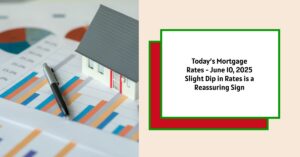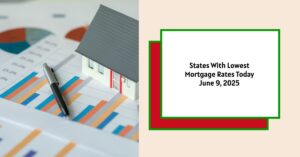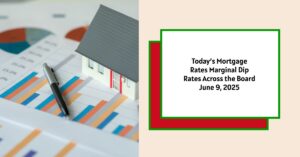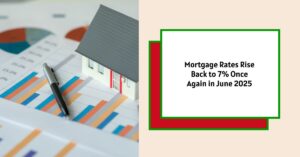On June 10, 2025, mortgage rates have seen a modest decrease. According to Zillow, the average 30-year fixed mortgage rate is now at 6.98%, down from 6.99% previously. Meanwhile, refinance rates for a 30-year fixed mortgage have dropped to 7.16%, a decline from 7.25% last week. This slight dip in rates is a reassuring sign for many potential homebuyers and those considering refinancing their existing loans.
Today’s Mortgage Rates – June 10, 2025: Slight Dip in Rates is a Reassuring Sign
Key Takeaways
- Current 30-year fixed mortgage rate: 6.98%
- Current refinance rate for 30-year fixed: 7.16%
- Market factors: Bond yields have fallen as investors await key economic news.
- Predictions: Rates are expected to remain stable, with a possibility of a downward trend in the coming months.
The Mortgage Market's Recent Trends
The mortgage market has been operating in a complex environment influenced by various economic factors. Over the past year, potential homebuyers and homeowners alike have experienced a rollercoaster ride with rates, driven by Federal Reserve policies, inflation concerns, and shifts in the housing market. As of June 10, 2025, the average rates reflect an industry striving for stability while reacting to ongoing economic signals.
The 30-year fixed mortgage rate serves as a primary benchmark for home financing. Many people favor this type due to its predictability—once secured, the interest rate remains constant throughout the life of the loan. Currently, the rate stands at 6.98%, offering a semblance of relief for homebuyers after an extended period of heightened rates.
Breakdown of Current Mortgage Rates
Different mortgage options are available, and knowing the current market rates can help you determine which product best suits your needs. Below, we provide an overview of rates categorized by loan types: conforming loans, government loans, and jumbo loans.
Conforming Loans
These loans meet the underwriting guidelines set by Fannie Mae and Freddie Mac, making them widely available and typically featuring competitive rates.
| PROGRAM | RATE | 1W CHANGE | APR | 1W CHANGE |
|---|---|---|---|---|
| 30-Year Fixed Rate | 6.98% | down 0.01% | 7.44% | down 0.01% |
| 20-Year Fixed Rate | 6.80% | down 0.02% | 7.29% | up 0.05% |
| 15-Year Fixed Rate | 6.07% | up 0.01% | 6.37% | up 0.01% |
| 10-Year Fixed Rate | 6.16% | up 0.23% | 6.52% | up 0.35% |
| 7-Year ARM | 8.41% | up 0.60% | 8.75% | up 0.52% |
| 5-Year ARM | 7.38% | down 0.24% | 7.88% | down 0.12% |
Source: Zillow
Government Loans
These loans are backed by governmental entities (FHA, VA, USDA), making them more accessible for first-time buyers or those with lower credit scores.
| PROGRAM | RATE | 1W CHANGE | APR | 1W CHANGE |
|---|---|---|---|---|
| 30-Year Fixed Rate FHA | 6.92% | up 0.01% | 7.96% | up 0.01% |
| 30-Year Fixed Rate VA | 6.45% | 0.00% | 6.66% | down 0.01% |
| 15-Year Fixed Rate FHA | 5.88% | up 0.20% | 6.87% | up 0.20% |
| 15-Year Fixed Rate VA | 5.94% | down 0.04% | 6.30% | down 0.02% |
Jumbo Loans
Jumbo loans refer to mortgages that exceed the conforming loan limits set by government-sponsored enterprises. These loans typically have higher interest rates.
| PROGRAM | RATE | 1W CHANGE | APR | 1W CHANGE |
|---|---|---|---|---|
| 30-Year Fixed Rate Jumbo | 7.35% | down 0.07% | 7.76% | down 0.04% |
| 15-Year Fixed Rate Jumbo | 6.35% | down 0.41% | 6.67% | down 0.35% |
| 7-Year ARM Jumbo | 7.53% | 0.00% | 8.06% | 0.00% |
| 5-Year ARM Jumbo | 8.28% | up 0.61% | 8.40% | up 0.34% |
Understanding Mortgage Types and Their Implications
When evaluating mortgage options, it’s important to understand the differences between fixed-rate and adjustable-rate mortgages (ARMs). Fixed-rate mortgages, as mentioned earlier, provide stability, while ARMs often start with lower rates that may increase after a predetermined period. For instance, a 7-year ARM may offer a low rate initially, but future adjustments can lead to higher payments once the adjustment period expires.
Moreover, the choice between a long-term loan and a short-term loan can significantly impact your monthly payments and the overall cost of borrowing. In general, shorter-term loans tend to come with lower interest rates but higher monthly payments. For example, a 15-year fixed mortgage carries an interest rate of 6.07%, which, though slightly higher than rates on more extended terms, allows homeowners to pay off their debt more quickly and often leads to substantial interest savings over the life of the loan.
Current Refinance Rates
For many homeowners, refinancing an existing mortgage offers a chance to obtain a lower interest rate, reduce monthly payments, or withdraw equity for other financial needs. As of June 10, 2025, refinance rates are seeing slight reductions, which may appeal to homeowners considering this path.
| PROGRAM | RATE | 1W CHANGE | APR | 1W CHANGE |
|---|---|---|---|---|
| 30-Year Fixed | 7.16% | down 0.09% | 7.44% | down 0.01% |
| 20-Year Fixed | 6.80% | down 0.02% | 7.29% | up 0.05% |
| 15-Year Fixed | 6.13% | up 0.06% | 6.37% | up 0.01% |
| 10-Year Fixed | 6.16% | up 0.23% | 6.52% | up 0.35% |
| 5-Year ARM | 8.20% | 0.00% | 8.20% | 0.00% |
Source: Zillow
The Economic Context
Understanding mortgage rates also involves recognizing the broader economic context. Recent decreases in bond yields indicate a cautious approach among investors regarding upcoming economic data. Investors are awaiting fresh insights into inflation and trade relations, particularly with significant meetings scheduled between key players in the global economy.
A notable aspect is the 10-year Treasury yield, which influences mortgage rates directly. As this benchmark yield falls, it generally leads to lower mortgage rates. On Monday, the yield fell by 0.62%, with investors holding their positions until the release of crucial inflation data this week. Experts anticipate that inflation, while still a concern, might show signs of stabilization, which would positively impact mortgage rates.
Predictions for Future Mortgage Rates
Looking ahead, various agencies and organizations have made predictions about the trajectory of mortgage rates over the next few months based on evolving economic conditions. Here are key insights from leading experts:
- Fannie Mae: Forecasts suggest that the average 30-year fixed mortgage rate could stabilize around 6.7% in the third quarter of 2025, easing to about 6.6% by year-end. They believe that the economic fundamentals will help create a more favorable lending environment.
- Mortgage Bankers Association (MBA): Similar to Fannie Mae, the MBA projects a downward trend, with expectations that rates may reach 6.6% before 2025 concludes.
- Economists from Various Institutions: Analysts from diverse sectors, including the National Association of Realtors and Morgan Stanley, express similar viewpoints, suggesting a gradual decline in mortgage rates as inflationary pressures ease and the housing market stabilizes.
Read More:
Mortgage Rates Trends as of June 9, 2025
The Psychological Impact on Homebuyers
The fluctuating rates can significantly impact buyer psychology. The continual conversations about rising home prices and mortgage rates often create a sense of urgency or anxiety among potential buyers. Many feel strained to make purchases quickly, fearing that delaying decisions could result in skyrocketing costs.
One crucial insight from recent studies suggests that while higher mortgage rates may deter some buyers, they also often lead to increased competition. With fewer affordable homes available, potential buyers face challenges in negotiating purchasing prices, making it essential to stay informed and act strategically in the homebuying process.
Conclusion
As of June 10, 2025, mortgage rates are positioned at 6.98% for a 30-year fixed mortgage, reflecting a slight but notable decrease from previous weeks. Homebuyers and those contemplating refinancing should be aware of the current market conditions and the various factors at play.
The mortgage landscape constantly evolves, influenced by economic indicators, housing market dynamics, and investor sentiments. Sticking to reliable sources and staying informed about how these elements might affect rates will empower borrowers to make more informed financial choices moving forward.
Invest Smarter in a High-Rate Environment
With mortgage rates remaining elevated this year, it's more important than ever to focus on cash-flowing investment properties in strong rental markets.
Norada helps investors like you identify turnkey real estate deals that deliver predictable returns—even when borrowing costs are high.
HOT NEW LISTINGS JUST ADDED!
Connect with a Norada investment counselor today (No Obligation):
(800) 611-3060
Also Read:
- Will Mortgage Rates Go Down in 2025: Morgan Stanley's Forecast
- Expect High Mortgage Rates Until 2026: Fannie Mae's 2-Year Forecast
- Mortgage Rate Predictions 2025 from 4 Leading Housing Experts
- Mortgage Rates Forecast for the Next 3 Years: 2025 to 2027
- 30-Year Mortgage Rate Forecast for the Next 5 Years
- 15-Year Mortgage Rate Forecast for the Next 5 Years
- Why Are Mortgage Rates Going Up in 2025: Will Rates Drop?
- Why Are Mortgage Rates So High and Predictions for 2025
- Will Mortgage Rates Ever Be 3% Again in the Future?
- Mortgage Rates Predictions for Next 2 Years
- Mortgage Rate Predictions for Next 5 Years
- Mortgage Rate Predictions: Why 2% and 3% Rates are Out of Reach
- How Lower Mortgage Rates Can Save You Thousands?
- How to Get a Low Mortgage Interest Rate?
- Will Mortgage Rates Ever Be 4% Again?











